Beyond the Grid: Branding in Non-Euclidean Space

At first glance, geometry might seem like an unlikely source of inspiration for branding. But here at Otherwise, we often find our metaphors in what’s structural, not in what’s trending. Ideas that hold space and shape perception keep us on our toes.
For centuries, Euclidean geometry — the geometry of lines, angles, planes — offered a stable map of reality. It gave us clarity, order, logic. It also gave us grids, systems, hierarchies. It gave us the visual scaffolding of modernist brands and identity systems.
But as our world has changed — more networked, more entangled, more multidimensional — so too must our mental models. So it’s time to reconsider Non-Euclidean geometry. A geometry of curved space, infinite loops, and warped dimensions. A geometry that asks: what if space doesn’t behave the way we thought it did?
In branding, this serves as a daily question.
A Brief History of Non-Euclidean Geometry
For over two thousand years, the geometry of Euclid was regarded as the unquestioned truth of spatial reasoning. Rooted in the work of the Greek mathematician who made his mark in 300 BC, it described the properties of flat space: straight lines, parallel lines that never meet, and the familiar sum of 180 degrees in a triangle. This system formed the basis of everything from Renaissance architecture to Enlightenment thinking. It was seen as the rational foundation for understanding the physical world — elegant, orderly, and immutable. But in the 19th century, mathematicians began to question one of Euclid’s central postulates: the parallel postulate, which states that only one line can be drawn parallel to a given line through a point not on that line.
The thinkers Carl Friedrich Gauss, Nikolai Lobachevsky, and János Bolyai began exploring what would happen if this postulate didn’t hold — if multiple lines could be drawn, or none at all. What they discovered was not chaos, but a whole new system of geometry. One where space itself could curve, and where familiar rules dissolved into strange, but internally consistent logic.
This was the birth of Non-Euclidean geometry — and with it a radical expansion of spatial possibility.
Later, Einstein would use these ideas to develop his theory of general relativity, showing that gravity is not a force but a curvature of spacetime. What had once seemed impossible or illogical became central to modern physics and cosmology.
The lesson? Systems that once felt inevitable may simply be inherited. And other geometries are always possible.
The Grid is Breaking
Traditional brand systems — like Euclidean geometry — are built on straight lines and predictable rules. Consistency becomes the highest virtue. Guidelines are enforced like laws of nature. Identity is fixed, tidy, rational. But increasingly, these systems strain under the complexity of real life. A brand isn’t one message in one medium. It’s a constellation of interactions, references, contexts, and perceptions — many of which the brand doesn’t even control. What emerges is something far messier, and far more alive.
Non-Euclidean geometry reminds us that not all paths are linear. That parallel lines can curve. That spaces can bend around themselves. And that in complex systems — like brand ecosystems — flattening everything into grids only obscures the richness.
Curved Space, Curved Identity
A Non-Euclidean brand doesn’t insist on rigid uniformity. It moves in curves. It adapts to context. It allows for gravitational pull — toward culture, community, conversation. Instead of striving for coherence through control, it achieves resonance through flexibility. It makes room for contradictions. It allows for multi-dimensional expression. This doesn’t mean a brand loses its integrity. It means it learns to hold plurality without collapsing. To become a system that behaves more like a living surface than a sealed blueprint.
From Coordinates to Fields
Euclidean thinking tends to define space by position: a point here, a line there. Non-Euclidean geometry shifts the model. Space becomes a field — shaped not by fixed positions, but by relationships, distortions, and flows. In branding, this opens up a beautiful metaphor: what if your brand isn’t a fixed point of identity, but a gravitational field? Something that shapes behavior, attracts orbiting ideas, and bends perception around its presence? Brands that think this way don’t rely on central messaging alone. They cultivate atmosphere. They allow for drift. And in the process, they don’t just assert — they influence.
Warped Time, Flexible Meaning
Because time and space are not constants in Non-Euclidean geometry, they bend in relation to velocity and gravity. Similarly, a brand’s meaning is not stable across all audiences or eras. It warps over time.
A brand that clings to its original coordinates may one day find itself speaking into a void. But a brand that understands identity as a moving structure — that allows meaning to accumulate, dissolve, and reassemble — will remain relevant even as its form changes.
Brand as Topology
At Otherwise, we imagine brand systems as topologies — shapes that stretch, bend, evolve, and adapt. We’re less interested in perfect alignment than in graceful tension. Less invested in linear hierarchy than in interconnected surface.
We believe the most resonant brands sidestep the default to present themselves as flat, symmetrical, or airtight. They’re the ones that allow space to bend — to hold complexity, contradiction, and change without breaking.
So when we’re shaping a brand, we ask:
- What kinds of dimensional movement does this brand allow?
- Where are the folds, the curves, the unseen surfaces?
- How do people experience the brand from different vantage points — and what patterns emerge in the distortion?
Rethinking Consistency in a Curved World
In a Non-Euclidean world, the shape of space itself is dynamic —it bends around forces, stretching in response to movement. What was once parallel may eventually meet. What was once linear may suddenly loop. Here, brand identity moves beyond a fixed grid to become a field that flexes across time, culture, and context. Its meaning is shaped through relation, not in isolation.
Armed with this way of thinking, it’s now possible to reconsider how we engage with the idea of consistency, dispensing with the notion that it is about staying the same. Instead, consistency is about staying coherent with motion, honoring the throughline as the path curves. It reminds us that the brands that last are the ones that don’t stand still, but rather move with integrity, with awareness, and with dimensional grace.








